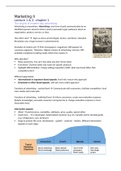Marketing II
Lecture 1 & 2: chapter 1
The origins of modern-day advertising
Advertising is everywhere. Advertising= any form of paid communication by an
identified sponsor aimed to inform and/or persuade target audiences about an
organization, product, service, or idea.
How did it start? Signs as old as ancient Egypt, Greece, and Rome. Industrial
Revolution saw a huge increase in advertisement
Evolution of modern ads Print (newspapers, magazines). Still popular for
consumer segments. Television. Highest volume of advertising. Internet. Will
probably compliment existing media rather than replace it.
Why advertise?
Raise awareness. You can’t buy what you don’t know exists
Fuel desire. Channel needs into wants for specific products
Highlight differentiation. Unique selling proposition (USP): what one brand offers that
competitors don’t
Different approaches:
Informational or argument-based appeals. Hard-sell, reason-why approach
Emotional or affect-based appeals. Soft-sell, more subtle approach
Functions of advertising – societal level Communicate with consumers, facilitate competition, fund
mass media and create jobs
Functions of advertising – individual level Inform consumers, create non-evaluative response
(beliefs, knowledge), persuade consumers and generate or change evaluative response (a more
favourable view)
Information appeals
What? performance, availability, attributes, price, quality, special offers
Used more... in developed, industrialized countries (e.g. US, Canada) and for durable goods
(e.g. refrigerators, cars, furniture)
Stage in product life cycle. Introduction – growth – maturity – decline. Different information
appeals on each stage.
, Educate consumers. Complex new product or services.
Deal with problems. Corrections / recalls.
Limitations: informing consumers might sometimes be ineffective or even
backfire McDonald’s case
o Memory and associations (worms with hamburger)
o Customer survey
Persuasion appeals
Change consumer responses. Mainly influence feelings, preferences, attitudes.
Alpha strategies
o Increase approach motivation
o Move towards advocated position
o Through arguments, incentives, scarcity...
Omega strategies
o Reduce avoidance motivation
o Reduce resistance towards advocated position
o Through counterarguments, distractions, attempts to make the message look less like
persuasion, negative emotions like fear or guilt...
The effects of advertising: a psychological perspective
Effects of advertising at the individual level: Relationships between ad stimuli and consumer
responses; Understanding the psychological processes behind these relationships
o Other approaches: naïve, economic, media, creative
Consumer responses:
Cognitive responses beliefs and thoughts about brands or products. E.g. brand awareness,
recognition, attitude, preference
Affective responses transient emotions and moods. E.g. fear, pride, sadness, anger
Behavioural responses intention and actual behaviour. E.g. purchase, choice, product trial,
brand switching
Assessing consumer responses
Correlational relationships: a change in one variable is associated with a change in the other.
Positive / negative or zero. Make predictions (once the values of one variable are known)
o Number of arguments in an ad message and attitude towards the advertised product
Both ice cream sales and shark attacks increase when the
weather is hot and sunny, but they are not caused by each
other (they are caused by good weather, with lots of
people at the beach, both eating ice cream and having a
swim in the sea).
,Correlational relationships and the third variable problem (image)
Causal relationships
o Three conditions: A must precede B (temporal sequence of
events), changes in A must be associated with changes in B
(correlation), the change in B should only be attributed to
changes in A – no other explanations should be plausible (third
variable problem).
o Correlation: necessary but not sufficient condition for causality
Experiments
o Manipulate A - independent variable (IV)
o Assess impact on B – dependent variable (DV)
o Random assignment – no systematic differences before the IV was
manipulated. Any effects on the DV can be attributed to the IV
o Example Manipulate number of argument (IV). 2 arguments vs. 5
arguments. Random assignment. Assess impact on attitude towards
product (DV).
Moderation
o The effect of A on B depends on C (moderator)
o Interaction between A and C on B
o Moderators can be individual differences or contextual variables
Advertising effects are a combination of situational and person
variables
Advertising effects are not invariant across consumers and situations
o Example the effect of number of arguments
on attitude towards the product depends on the
degree of consumer involvement (i.e., there is
an interaction between number of arguments
and consumer involvement)
IV1: number of arguments. 2 vs. 5 arguments
IV2: consumer involvement (moderator).
Individual difference (measured)
DV: attitude towards the product
Interaction of
arguments and
consumer
involvement
Target high involvement customers – use 5
arguments
Target low involvement customers - use 2
arguments
, Main effect of number of arguments
5 arguments are more effective than 2 arguments.
Main effect of consumer involvement
Number of arguments does not have any impact.
Higher involvement leads to more positive attitude
than low involvement.
Main effect of number of arguments
Main effect of consumer involvement
Higher involvement, more positive attitude
At the same time, 5 arguments higher than 2
arguments.
No main effects
No interaction
- No significant difference
Factorial experiments
o Two or more independent variables
o Main effects
o Interaction effects
Mediation analysis
o Digging deeper into the reasons
o Identify the intermediary psychological process
responsible for an effect
o Logic: controlling for the mediator significantly
reduces the effect of the IV on the DV
o Example number of arguments: positive impact on
attitude towards a product. Why? Amount of
thoughts generated
Approaches of conceptualizing advertising effectiveness
1. Modelling approach
o Aggregate level Entire markets or market segments
2. Behavioural approach






